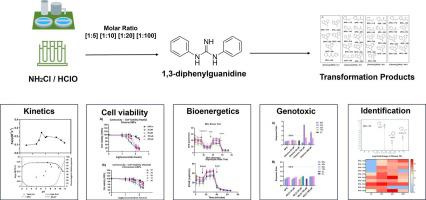当前位置:
X-MOL 学术
›
Sci. Total Environ.
›
论文详情
Our official English website, www.x-mol.net, welcomes your
feedback! (Note: you will need to create a separate account there.)
Comparison of monochloramination and chlorination of 1,3-diphenylguanidine (DPG): Kinetics, transformation products, and cell-based in-vitro testing
Science of the Total Environment ( IF 8.2 ) Pub Date : 2023-10-12 , DOI: 10.1016/j.scitotenv.2023.167743 Lebing Ying 1 , Mauricius Marques Dos Santos 2 , Shenglan Jia 2 , Caixia Li 2 , Theodora H Y Lee 2 , Anette Tele Mensah 2 , Shane Allen Snyder 1
Science of the Total Environment ( IF 8.2 ) Pub Date : 2023-10-12 , DOI: 10.1016/j.scitotenv.2023.167743 Lebing Ying 1 , Mauricius Marques Dos Santos 2 , Shenglan Jia 2 , Caixia Li 2 , Theodora H Y Lee 2 , Anette Tele Mensah 2 , Shane Allen Snyder 1
Affiliation

|
As a widely used secondary vulcanization accelerator in the rubber industry, 1,3-diphenylguanidine (DPG) poses risks to human health and the environment. To compare and comprehend the disinfection process of DPG, this work investigates the reaction kinetics, toxicity, and transformation products (TPs) of DPG during chlorination and monochloramination. It has been revealed that the reactivity of monochloramine is significantly slower compared to chlorination of DPG, with the maximum efficiency observed at pH 7 to pH 8. Cytotoxicity assessment using HepG2 and THP-1 cells reveals that cytotoxicity hierarchy is as follows: chlorine TPs > monochloramine TPs > DPG. Moreover, oxidant-to-DPG molar ratios 10 and 20 lead to higher cytotoxicity in both chlorination and monochloramination compared to ratio 5 and 100. Additionally, cell bioenergetics experiments demonstrate that chlorine and monochloramine TPs induce mitochondrial dysfunction and enhance glycolytic function in HepG2 cells. The genotoxic response from p53 signaling further suggested genotoxic effects of certain TPs. Furthermore, analysis of TPs using high-resolution mass spectrometry (HRMS) identifies ten TPs, with chlorination yielding more TPs than monochloramination. Generally, a chlorine or monochloramine molar ratio to DPG of 10–20 results in an increased formation of TPs and heightened cytotoxicity. Notably, higher oxidant molar ratios increased the formation of monoguanidine TPs and DPG hydroxylation during chlorination, whereas monochloramination lead to DPG substitution predominantly generating chlorinated DPG due to weaker oxidation effects. These findings provide valuable information for the appropriate treatment of DPG and disinfection processes in water facilities to mitigate potential risks to human health and the ecosystem.
中文翻译:

1,3-二苯胍 (DPG) 的一氯胺化和氯化的比较:动力学、转化产物和基于细胞的体外测试
1,3-二苯胍(DPG)作为橡胶工业中广泛使用的二次硫化促进剂,对人类健康和环境构成风险。为了比较和理解 DPG 的消毒过程,本工作研究了 DPG 在氯化和一氯胺过程中的反应动力学、毒性和转化产物 (TP)。研究表明,与 DPG 的氯化相比,一氯胺的反应活性明显较慢,在 pH 7 至 pH 8 时观察到最大效率。使用 HepG2 和 THP-1 细胞进行的细胞毒性评估表明,细胞毒性等级如下:氯 TP >一氯胺 TP > DPG。此外,与比率 5 和 100 相比,氧化剂与 DPG 摩尔比为 10 和 20 会导致氯化和一氯胺化中更高的细胞毒性。此外,细胞生物能学实验表明,氯和一氯胺 TP 会诱导线粒体功能障碍并增强 HepG2 细胞中的糖酵解功能。p53 信号传导的基因毒性反应进一步表明某些 TP 的基因毒性作用。此外,使用高分辨率质谱 (HRMS) 对 TP 进行分析,确定了 10 种 TP,其中氯化产生的 TP 多于一氯胺化。一般来说,氯或一氯胺与 DPG 的摩尔比为 10-20 会导致 TP 形成增加并增强细胞毒性。值得注意的是,较高的氧化剂摩尔比增加了氯化过程中单胍TPs和DPG羟基化的形成,而一氯胺化导致DPG取代,由于氧化作用较弱,主要产生氯化DPG。这些发现为水设施中 DPG 的适当处理和消毒过程提供了宝贵的信息,以减轻对人类健康和生态系统的潜在风险。
更新日期:2023-10-12
中文翻译:

1,3-二苯胍 (DPG) 的一氯胺化和氯化的比较:动力学、转化产物和基于细胞的体外测试
1,3-二苯胍(DPG)作为橡胶工业中广泛使用的二次硫化促进剂,对人类健康和环境构成风险。为了比较和理解 DPG 的消毒过程,本工作研究了 DPG 在氯化和一氯胺过程中的反应动力学、毒性和转化产物 (TP)。研究表明,与 DPG 的氯化相比,一氯胺的反应活性明显较慢,在 pH 7 至 pH 8 时观察到最大效率。使用 HepG2 和 THP-1 细胞进行的细胞毒性评估表明,细胞毒性等级如下:氯 TP >一氯胺 TP > DPG。此外,与比率 5 和 100 相比,氧化剂与 DPG 摩尔比为 10 和 20 会导致氯化和一氯胺化中更高的细胞毒性。此外,细胞生物能学实验表明,氯和一氯胺 TP 会诱导线粒体功能障碍并增强 HepG2 细胞中的糖酵解功能。p53 信号传导的基因毒性反应进一步表明某些 TP 的基因毒性作用。此外,使用高分辨率质谱 (HRMS) 对 TP 进行分析,确定了 10 种 TP,其中氯化产生的 TP 多于一氯胺化。一般来说,氯或一氯胺与 DPG 的摩尔比为 10-20 会导致 TP 形成增加并增强细胞毒性。值得注意的是,较高的氧化剂摩尔比增加了氯化过程中单胍TPs和DPG羟基化的形成,而一氯胺化导致DPG取代,由于氧化作用较弱,主要产生氯化DPG。这些发现为水设施中 DPG 的适当处理和消毒过程提供了宝贵的信息,以减轻对人类健康和生态系统的潜在风险。

































 京公网安备 11010802027423号
京公网安备 11010802027423号